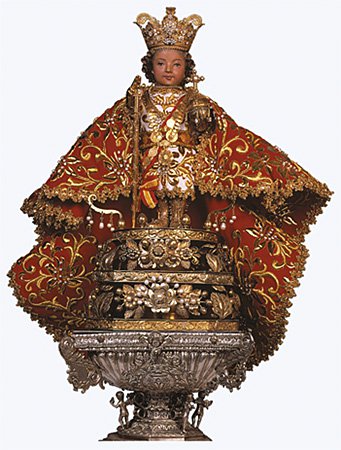Cultural Center of the Philippines
ENCYCLOPEDIA OF
PHILIPPINE ART
Santo Niño de Cebu
Early 16th century / Wood / Approximately 90 cm in height / Basilica Minore del Sto. Niño, Cebu City
When Miguel Lopez de Legazpi and his troops landed in the island of Sugbu (former name of Cebu) on 28 Apr 1565, they burned down the whole settlement they found there to drive all residents out of the land. The statue of the Santo Niño was discovered among the ruins by Juan de Camus, one of Legazpi’s sailors. The icon was wrapped in white cloth and kept inside a Spanish crafted wooden box. The image’s survival from destruction by fire and its discovery were considered miracles, and Legazpi decreed the propagation of the devotion to the Holy Child. This is the first of the multitude of devotions to the Holy Child in various localities in the Philippines (Bautista 2001, 15-16). The image was then entrusted to the Augustinian Missionaries and six years after, a church was built on the site where it was found. This church was named after the Holy Name of Jesus and is considered to be the first Christian church ever built on the Philippines (Florendo 2001, 27).
The primary historical significance of the image of the Santo Niño de Cebu lies in the theory that it was among the images that Ferdinand Magellan brought with him from Spain in 1521 (Jose 1991, 117). The image of the Holy Child that Magellan brought is said to be a product of the Spanish colony of Flanders in Belgium. Carved in wood, it was dressed up in the traditional costume for children of the Spanish court of the late 16th and the 17th centuries. It had a long-sleeved shirt with lace ruffles and gold-embroidered vest over a pair of trousers tucked into a pair of gold boots worn up through the middle lower legs. The image also wears a princely ensemble comprised of a crown, a sash, a belt, and a long flowing cape. The Holy Child’s right hand is raised in benediction, as it holds a scepter symbolizing martial law and power to impose justice. Its left hand holds an orb with a cross, symbolizing the dominion of the child Jesus over all creation and the sovereignty of Spain over a vast territory around the globe (Bautista 2001, 13). The vestment of the Santo Niño de Cebu is predominantly red. The image stands on a tall ornamented pedestal. Noteworthy adornments of the image include a chain of old Spanish gold coins, the toisonne allegedly bequeathed by King Charles III, and a golden ram pendant. The image was originally ebony in color but was repainted in pale yellow after World War II to conceal a scratch on the image’s right cheek (Florendo 2001, 21).
According to the account of Magellan’s chronicler, Antonio de Pigafetta, a beautiful image of the Holy Child with other images was presented to Hara Amihan, the wife of Rajah Humabon of Cebu as she was baptized with the Christian name Juana. Juana was brought to tears as she beheld the image and thus asked that the image be left with her (Bautista 2001, 14-15). This account extended to tales of Juana leaping and dancing the sulog (the dance of the tides) along with her handmaidens as she took possession of the Santo Niño. Her reaction marked the warm reception and adoration the Filipinos have since accorded the Santo Niño. Juana’s jubilant acceptance of the image of the Holy Child has since been regarded as having given birth to the Sinulog dance and eventually the Sinulog festival, a celebration that honors the feast of the Holy Child of Cebu annually every second Sunday following the feast of the Epiphany. The Sinulog dance and festivities are punctuated with shouts of “Viva! Pit Senyor!” as the Holy Child is referred to by devotees as “Senyor Sto. Niño” (Florendo 2001, 57-9, 109).
Written by Dino Carlo S. Santos
Sources
Bautista, Benjamin Basilidez G. 2001. “The Niño Emerges from the Fire of the Golden Age.” In Santo Niño: The Holy Child Devotion in the Philippines, edited by Abe Florendo, 9-19. Manila: Benjamin Farrales and the Congregacion del Santissimo Nombre del Niño Jesus.
Florendo, Abe. 2001a. “The Beloved Child of the People.” In Santo Niño: The Holy Child Devotion in the Philippines, edited by Abe Florendo, 45-65. Manila: Benjamin Farrales and the Congregacion del Santissimo Nombre del Niño Jesus.
———. 2001b. “Myths and Miracles.” In Santo Niño: The Holy Child Devotion in the Philippines, edited by Abe Florendo, 21-37. Manila: Benjamin Farrales and the Congregacion del Santissimo Nombre del Niño Jesus.
———. 2001c. “Venerated Images of the Niño: Behold the Child.” In Santo Niño: The Holy Child Devotion in the Philippines, edited by Abe Florendo, 21-37. Manila: Benjamin Farrales and the Congregacion del Santissimo Nombre del Niño Jesus.
Jose, Regalado Trota. 1991. Simbahan: Church Art in Colonial Philippines 1565-1898. Makati City: Ayala Museum.
